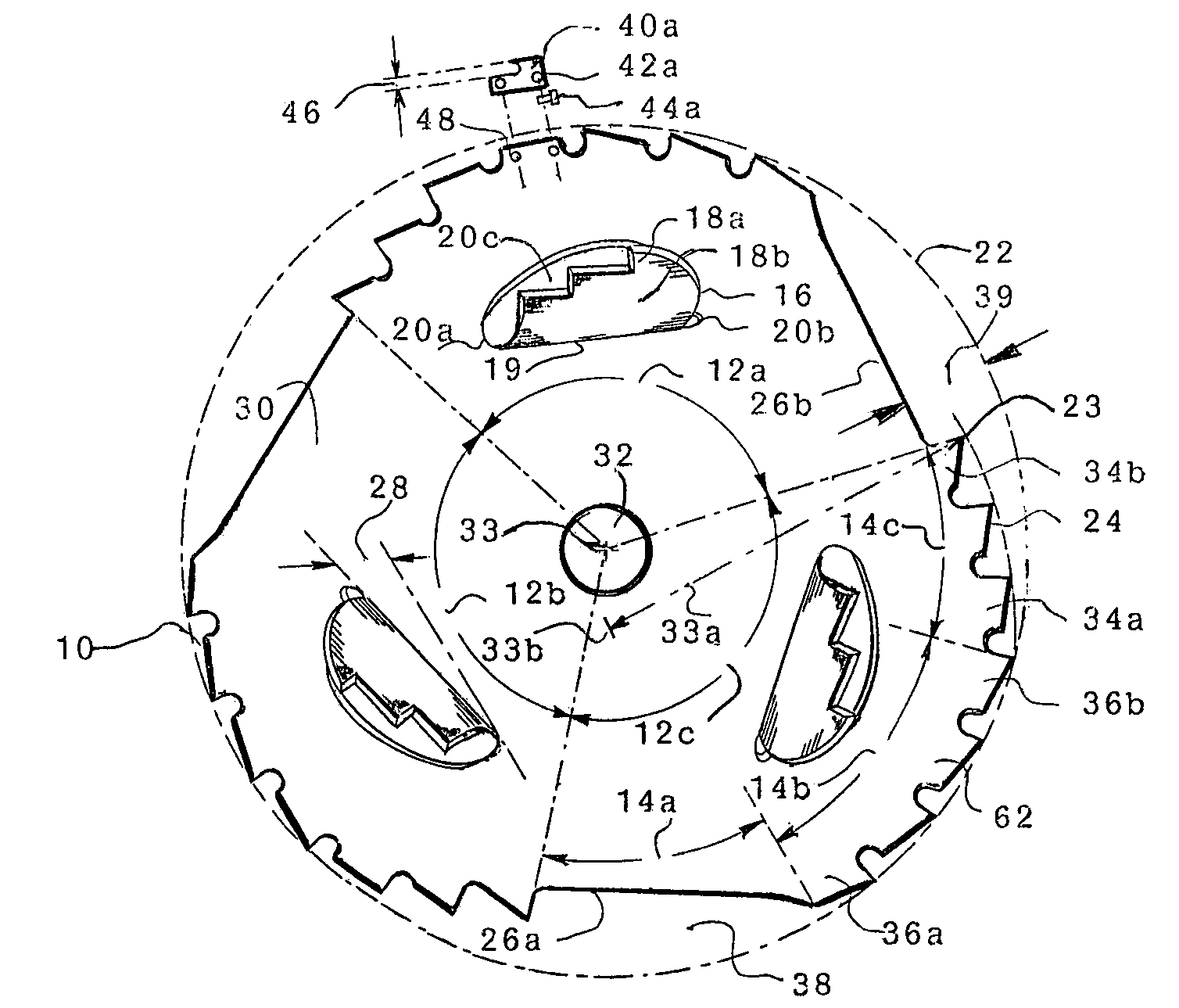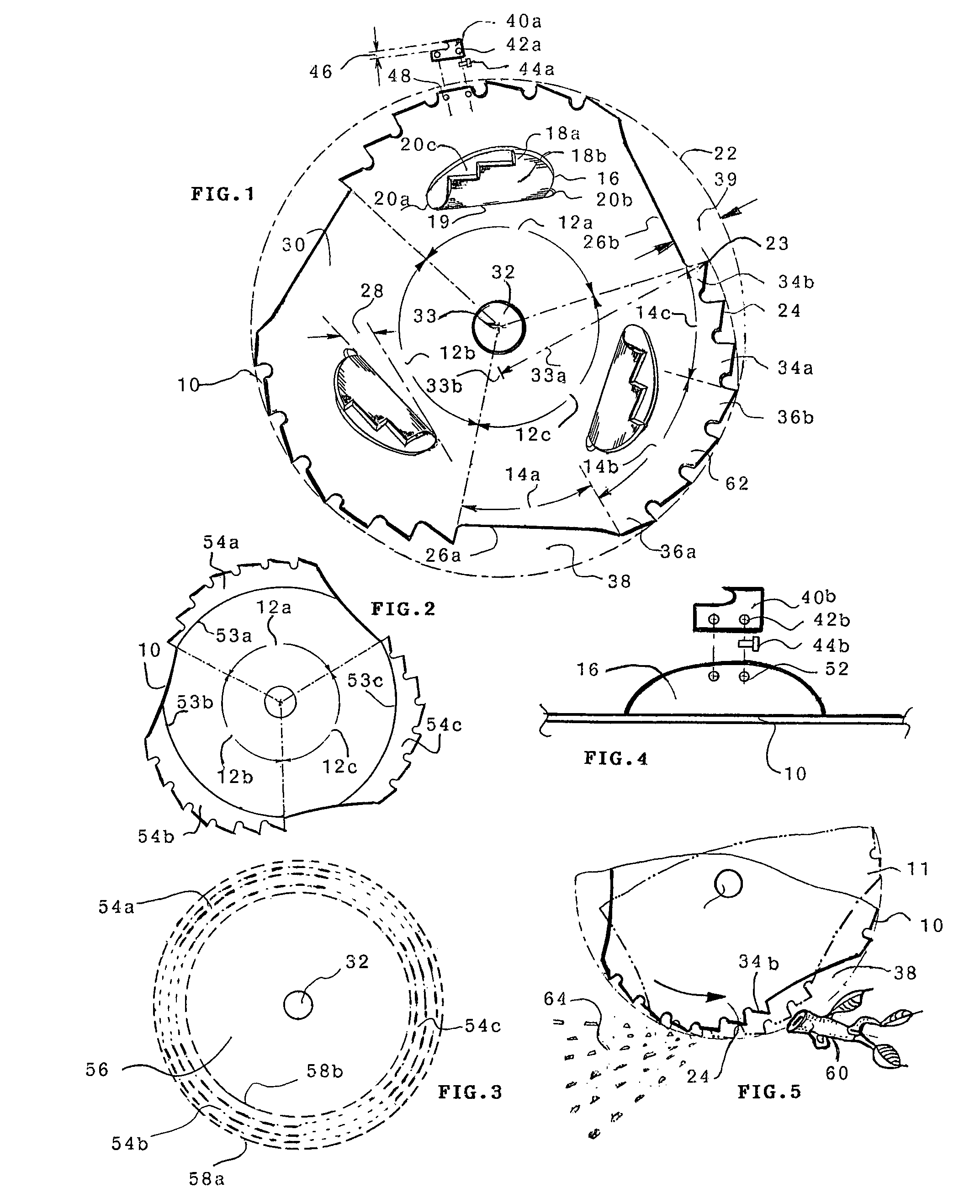Thus the traditional, conservative, design approach has resulted in many special purpose blades, but has produced no efficient all purpose blade, which can be used for the entire range of possible trimming tasks.
It not practical to shred wood several inches in
diameter with a
hand held brushcutter.
Some blades, however, are somewhere in between and do a little of each, that is some shredding and some cutting, without much effectiveness.
However, such saw blades have no effective shredding cability whatsoever, and so they leave the handling and disposal problems still unresolved.
Each presents a unique cutting or shredding problem.
Resorting to a different blade to fill each trimming need is inefficient.
However, even this quite efficient blade has one significant
weakness: it cannot shred at all on its backside.
Debris shields typically only give partial protection to the operator, because complete shielding would impair the functioning of the blade.
Rear mounted axial cutting elements, would cast hazardous debris toward the operator.
However, the blade on its return
stroke can only make straight lateral cuts.
While there is a field remedy—it is inconvenient.
Repeated over and over, endlessly, during a day's work, the extra movements add a significant
labor burden.
Thus the price paid in effort to achieve rearward shredding is unacceptable and a better solution needs to be found.
The greater the number of blade portions, usually, the smoother the cutting engagements, but at a cost of diminished shredding ability.
Fully
circular saw blades, for example, offer no effective shredding.
The Stretton blade is one of those blades somewhere in between; it does a little of each, but it can neither
cut nor shred very well.
Tooth structure variations offer no unique performance aspects, but the use of elastomers definitely limits any
heavy duty use.
However, the upruptly staggered cutting edges largely compromise the smooth cutting inherent in traditional disk saw blades.
No substantial saplings can be
cut with this blade.
U.S. Pat. No. 3,078,573 to Kern (1963) featuring only axial cutting elements without radial elements, again prevents radial cutting and is of very limited usefulness.
The comments made above for the Barrera patent similarly apply and this device is not useful for high speed brushcutters, because the disk is shielded by the bar which would flail into the first substantial sapling, or tree
branch and stop.
The blade is very effective but has an Achilles
heel.
They collect debris under certain conditions and this can lead to intermittent blade imbalances (Bemardy corrected this problem with U.S. Pat. No. 7,171,789, see above).
However, axial efficiency is somewhat less than what can be achieved with axially projected cutting elements as shown on the 2007 Bemardy patent.
b) They force the user to rely on different blades for different
field conditions.
c) They are capable of effective cutting only in radial directions.
d) They are capable of effective shredding only in axial directions.
e) They may have a combined, but then only marginal effectiveness in both radial and axial directions.
f) They are effective in both radial and forward axial directions, but have no shredding effectiveness in an axial rearward direction.
g) They are uneconomical to produce and may be relegated to an unprofitable market niche or have no real market whatsoever, i.e. ‘paper patents’.
h) They suffer excessively from a condition termed ‘kickback’, which is an undesirable torque reaction opposite to the direction of blade rotation and which may be unsafe.
i) They offer no way to clearly define and observe the cutting edge during use.
j) They heretofore are not capable of rendering excellent job performance in both a shredding and a cutting mode in unrestricted radial and axial directions, both forward and rearward, and with a low propensity for kickback.
 Login to View More
Login to View More  Login to View More
Login to View More 

